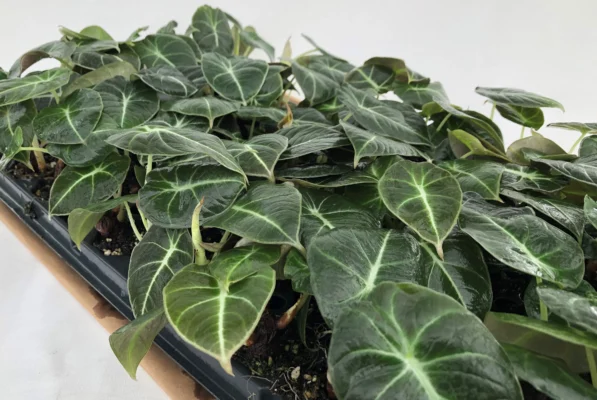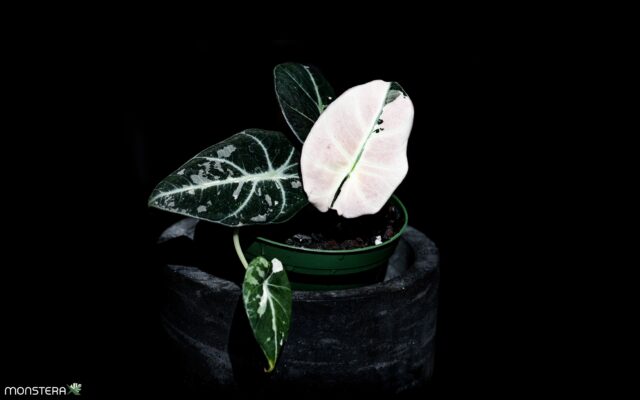In the world of rare houseplants, the Black Velvet Alocasia stands out as a true gem, captivating plant enthusiasts with its striking, velvety dark leaves and contrasting veins. This tropical rarity, also known as Alocasia reginula, combines the mystique of its dark foliage with the thrill of the hunt for collectors worldwide. Join us on a journey to uncover the secrets of successfully nurturing and propagating this exotic plant.
Unveiling the Enigmatic Black Velvet Alocasia: A Collector’s Dream
Tracing the Origins of a Rare Beauty: The Journey of the Black Velvet Alocasia
Native to Southeast Asia, the plant thrives under the canopy of tropical forests, where its dark leaves help it absorb as much light as possible in the dimly lit environments. This adaptation not only contributes to its survival but also to its unique aesthetic that plant collectors cherish.
Decoding the Allure: What Makes the Black Velvet Alocasia So Coveted?
The allure of the Black Velvet Alocasia lies in its spectacular foliage. The leaves are nearly black with striking white or silver veins, creating a dramatic visual contrast that can enhance any indoor plant collection. The velvety texture of its leaves adds a tactile dimension that makes this plant not just a visual delight but also a conversation starter.
Identifying the Black Velvet Alocasia: Distinguishing Features from Similar Species
Compared to its cousins, like the Alocasia Amazonica or Alocasia Frydek, the plant has smaller, more compact leaves, making it ideal for indoor settings where space is at a premium. Its distinct deep black coloring and textured leaves set it apart from other members of the Alocasia family.
Embracing the Challenge: Caring for the Black Velvet Alocasia
Recreating a Tropical Paradise: Providing Ideal Temperature and Humidity Levels
To thrive, the plant requires a warm, humid environment akin to its native tropical habitat. Maintaining indoor humidity levels around 60% and temperatures between 65-75°F will mimic these conditions, promoting healthy growth and preventing leaf crisping.
Mastering the Art of Watering: Finding the Balance for Optimal Growth
Watering is crucial for the Black Velvet Alocasia. The soil should be kept consistently moist but not waterlogged. Allow the top inch of soil to dry out before watering again to prevent root rot, a common issue with overwatering.
Nourishing the Velvet Beauty: Fertilizing for Lush Foliage and Vibrant Color
Feed the plant with a diluted balanced fertilizer every month during the growing season. This will support its robust growth and enhance the rich color of its leaves. In the dormant winter months, reduce feeding to prevent nutrient overload.
Propagating the Rarity: Expanding the Black Velvet Alocasia’s Legacy
Dividing the Clumps: Sharing the Abundance of the Black Velvet Alocasia
One of the most effective methods to propagate the Black Velvet Alocasia is by division during repotting. Carefully separate the rhizomes, ensuring each new plant has roots attached, and pot them individually.
Nurturing New Life from Stem Cuttings: Propagating the Essence of the Velvet Beauty
While more challenging, stem cuttings can also be used for propagation. Cut a healthy section of the stem with at least two nodes and plant in a moist, well-draining medium, ensuring high humidity and warmth.
Unveiling the Magic of Corms: Awakening Dormant Potential for New Growth
Corms, or bulb-like structures at the base of the plant, can be harvested and replanted to grow new Black Velvet Alocasias. This method is particularly rewarding as it allows gardeners to multiply their collection and share these rare beauties with fellow enthusiasts.
The quest for the plant, with its deep, mysterious hues and minimal care requirements, is a rewarding endeavor for any plant lover. By providing the right care, this rare plant can not only survive but thrive, adding a touch of the exotic to any indoor garden. Whether you’re a seasoned collector or a novice enchanted by its dark beauty, the Black Velvet Alocasia is a stunning addition that promises to enrich your plant collection and ignite your passion for rare botanical treasures.




